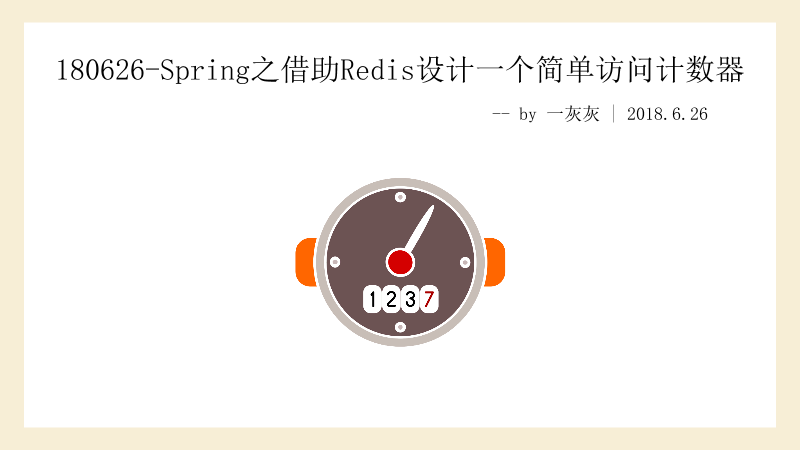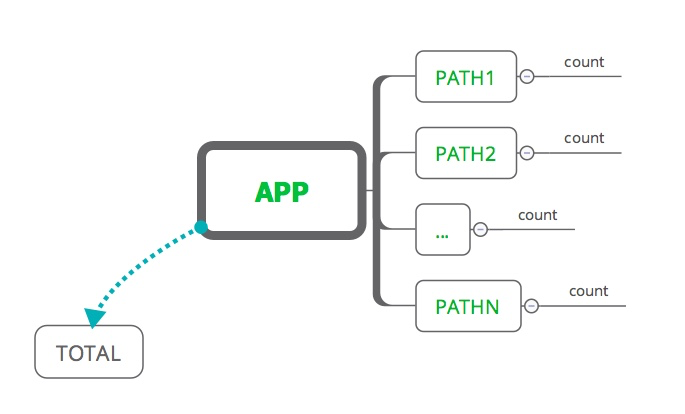Spring之借助Redis设计一个简单访问计数器

文章链接: liuyueyi.github.io/hexblog/201…
Spring之借助Redis设计一个简单访问计数器
为什么要做一个访问计数?之前的个人博客用得是卜算子做站点访问计数,用起来挺好,但出现较多次的响应很慢,再其次就是个人博客实在是访问太少,数据不好看:cry:...
前面一篇博文简单介绍了Spring中的RedisTemplate的配置与使用,那么这篇算是一个简单的应用case了,主要基于Redis的计数器来实现统计
I. 设计
一个简单的访问计数器,主要利用redis的hash结构,对应的存储结构如下:

存储结构比较简单,为了扩展,每个应用(or站点)对应一个APP,然后根据path路径进行分页统计,最后有一个特殊的用于统计全站的访问计数
II. 实现
主要就是利用Redis的hash结构,然后实现数据统计,并没有太多的难度,Spring环境下搭建redis环境可以参考:
- 180611-Spring之RedisTemplate配置与使用
1. Redis封装类
针对几个常用的做了简单的封装,直接使用RedisTemplate的excute方法进行的操作,当然也是可以使用 template.opsForValue() 等便捷方式,这里采用JSON方式进行对象的序列化和反序列化
public class QuickRedisClient {
private static final Charset CODE = Charset.forName("UTF-8");
private static RedisTemplate<String, String> template;
public static void register(RedisTemplate<String, String> template) {
QuickRedisClient.template = template;
}
public static void nullCheck(Object... args) {
for (Object obj : args) {
if (obj == null) {
throw new IllegalArgumentException("redis argument can not be null!");
}
}
}
public static byte[] toBytes(String key) {
nullCheck(key);
return key.getBytes(CODE);
}
public static byte[][] toBytes(List<String> keys) {
byte[][] bytes = new byte[keys.size()][];
int index = 0;
for (String key : keys) {
bytes[index++] = toBytes(key);
}
return bytes;
}
public static String getStr(String key) {
return template.execute((RedisCallback<String>) con -> {
byte[] val = con.get(toBytes(key));
return val == null ? null : new String(val);
});
}
public static void putStr(String key, String value) {
template.execute((RedisCallback<Void>) con -> {
con.set(toBytes(key), toBytes(value));
return null;
});
}
public static Long incr(String key, long add) {
return template.execute((RedisCallback<Long>) con -> {
Long record = con.incrBy(toBytes(key), add);
return record == null ? 0L : record;
});
}
public static Long hIncr(String key, String field, long add) {
return template.execute((RedisCallback<Long>) con -> {
Long record = con.hIncrBy(toBytes(key), toBytes(field), add);
return record == null ? 0L : record;
});
}
public static <T> T hGet(String key, String field, Class<T> clz) {
return template.execute((RedisCallback<T>) con -> {
byte[] records = con.hGet(toBytes(key), toBytes(field));
if (records == null) {
return null;
}
return JSON.parseObject(records, clz);
});
}
public static <T> Map<String, T> hMGet(String key, List<String> fields, Class<T> clz) {
List<byte[]> list =
template.execute((RedisCallback<List<byte[]>>) con -> con.hMGet(toBytes(key), toBytes(fields)));
if (CollectionUtils.isEmpty(list)) {
return Collections.emptyMap();
}
Map<String, T> result = new HashMap<>();
for (int i = 0; i < fields.size(); i++) {
if (list.get(i) == null) {
continue;
}
result.put(fields.get(i), JSON.parseObject(list.get(i), clz));
}
return result;
}
}
对应的配置类
package com.git.hui.story.cache.redis;
import com.git.hui.story.cache.redis.serializer.DefaultStrSerializer;
import org.springframework.cache.CacheManager;
import org.springframework.context.annotation.Bean;
import org.springframework.context.annotation.Configuration;
import org.springframework.context.annotation.PropertySource;
import org.springframework.core.env.Environment;
import org.springframework.data.redis.cache.RedisCacheManager;
import org.springframework.data.redis.connection.RedisConnectionFactory;
import org.springframework.data.redis.connection.RedisPassword;
import org.springframework.data.redis.connection.lettuce.LettuceConnectionFactory;
import org.springframework.data.redis.core.RedisTemplate;
/**
* Created by yihui in 18:45 18/6/11.
*/
@Configuration
@PropertySource(value = "classpath:application.yml")
public class RedisConf {
private final Environment environment;
public RedisConf(Environment environment) {
this.environment = environment;
}
@Bean
public CacheManager cacheManager() {
return RedisCacheManager.RedisCacheManagerBuilder.fromConnectionFactory(redisConnectionFactory()).build();
}
@Bean
public RedisTemplate<String, String> redisTemplate(RedisConnectionFactory redisConnectionFactory) {
RedisTemplate<String, String> redisTemplate = new RedisTemplate<>();
redisTemplate.setConnectionFactory(redisConnectionFactory);
DefaultStrSerializer serializer = new DefaultStrSerializer();
redisTemplate.setValueSerializer(serializer);
redisTemplate.setHashValueSerializer(serializer);
redisTemplate.setKeySerializer(serializer);
redisTemplate.setHashKeySerializer(serializer);
redisTemplate.afterPropertiesSet();
QuickRedisClient.register(redisTemplate);
return redisTemplate;
}
@Bean
public RedisConnectionFactory redisConnectionFactory() {
LettuceConnectionFactory fac = new LettuceConnectionFactory();
fac.getStandaloneConfiguration().setHostName(environment.getProperty("spring.redis.host"));
fac.getStandaloneConfiguration().setPort(Integer.parseInt(environment.getProperty("spring.redis.port")));
fac.getStandaloneConfiguration()
.setPassword(RedisPassword.of(environment.getProperty("spring.redis.password")));
fac.afterPropertiesSet();
return fac;
}
}
2. Controller 支持
首先是定义请求参数:
@Data
public class WebCountReqDO implements Serializable {
private String appKey;
private String referer;
}
其次是实现Controller接口,稍稍注意下,根据path进行计数的逻辑:
- 如果请求参数显示指定了referer参数,则用传入的参数进行统计
- 如果没有显示指定referer,则根据header获取referer
- 解析referer,分别对path和host进行统计+1,这样站点的统计计数就是根据host来的,而页面的统计计数则是根据path路径来的
@Slf4j
@RestController
@RequestMapping(path = "/count")
public class WebCountController {
@RequestMapping(path = "cc", method = {RequestMethod.GET})
public ResponseWrapper<CountDTO> addCount(WebCountReqDO webCountReqDO) {
String appKey = webCountReqDO.getAppKey();
if (StringUtils.isBlank(appKey)) {
return ResponseWrapper.errorReturnMix(Status.StatusEnum.ILLEGAL_PARAMS_MIX, "请指定APPKEY!");
}
String referer = ReqInfoContext.getReqInfo().getReferer();
if (StringUtils.isBlank(referer)) {
referer = webCountReqDO.getReferer();
}
if (StringUtils.isBlank(referer)) {
return ResponseWrapper.errorReturnMix(Status.StatusEnum.FAIL_MIX, "无法获取请求referer!");
}
return ResponseWrapper.successReturn(doUpdateCnt(appKey, referer));
}
private CountDTO doUpdateCnt(String appKey, String referer) {
try {
if (!referer.startsWith("http")) {
referer = "https://" + referer;
}
URI uri = new URI(referer);
String host = uri.getHost();
String path = uri.getPath();
long count = QuickRedisClient.hIncr(appKey, path, 1);
long total = QuickRedisClient.hIncr(appKey, host, 1);
return new CountDTO(count, total);
} catch (Exception e) {
log.error("get referer path error! referer: {}, e: {}", referer, e);
return new CountDTO(1L, 1L);
}
}
}
3. 实例
针对这个简单的redis计数,目前在个人的mweb和zweb两个页面已经接入,在页脚处可以看到对应的计数,每次刷新计数会+1
- mweb: liuyueyi.gitee.io/mweb/#/
- zweb: liuyueyi.gitee.io/zweb/#/
III. 其他
0. 相关博文
- 180611-Spring之RedisTemplate配置与使用
1.一灰灰Blog: https://liuyueyi.github.io/hexblog
一灰灰的个人博客,记录所有学习和工作中的博文,欢迎大家前去逛逛
2. 声明
尽信书则不如,已上内容,纯属一家之言,因个人能力有限,难免有疏漏和错误之处,如发现bug或者有更好的建议,欢迎批评指正,不吝感激
- 微博地址:小灰灰Blog
- QQ: 一灰灰/3302797840
正文到此结束
- 本文标签: zab parse 参数 统计 git IO redis key build update 文章 cat HashMap 解析 分页 core cache 数据 Collections Connection spring Word tar bug App REST src classpath bean UI json 微博 博客 js id CTO list dist 站点 Property 配置 实例 final http https Collection GitHub value client web connectionFactory map
- 版权声明: 本文为互联网转载文章,出处已在文章中说明(部分除外)。如果侵权,请联系本站长删除,谢谢。
- 本文海报: 生成海报一 生成海报二
热门推荐
相关文章
Loading...











![[HBLOG]公众号](https://www.liuhaihua.cn/img/qrcode_gzh.jpg)

